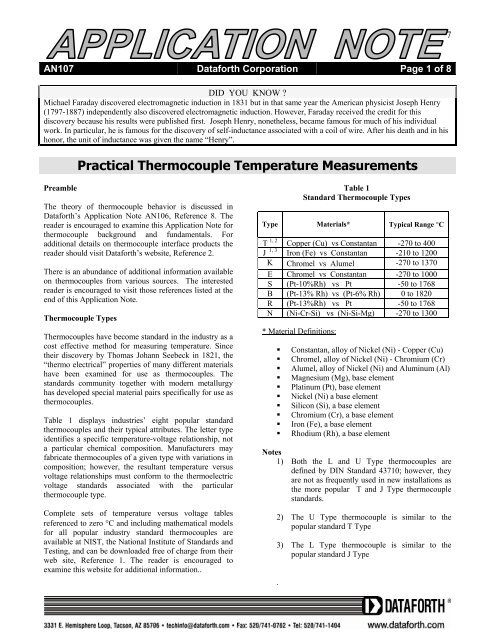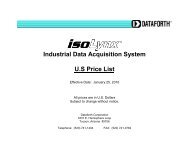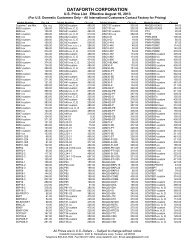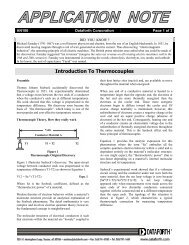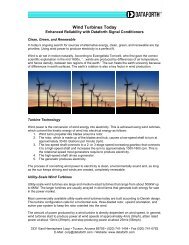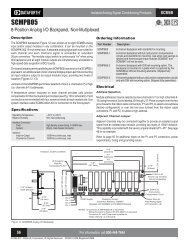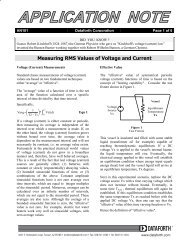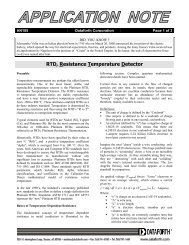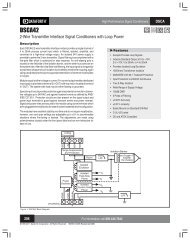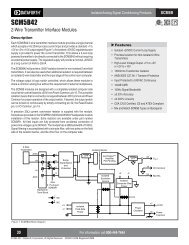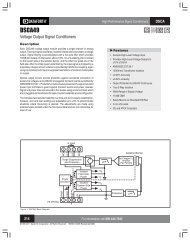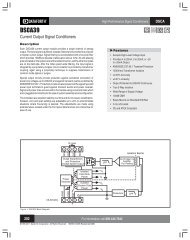Practical Thermocouple Temperature Measurements - Dataforth
Practical Thermocouple Temperature Measurements - Dataforth
Practical Thermocouple Temperature Measurements - Dataforth
Create successful ePaper yourself
Turn your PDF publications into a flip-book with our unique Google optimized e-Paper software.
AN107 <strong>Dataforth</strong> Corporation Page 2 of 8Three additional thermocouple types used for hightemperature measurements are C, D, and G Typethermocouples. Their designation letters (C, D, G) are notrecognized as standards by ANSI; nonetheless, they areavailable. Their wire compositions are;G Type: W vs W-26%ReC Type W-5%Re vs W-26%ReD Type W-5%Re vs W-25%ReWhere; “W” is Tungsten and “Re” is RheniumMost all practical temperature ranges can be measuredusing thermocouples; even though, their output full-scalevoltage is only millivolts with sensitivities in themicrovolts per degree range and their response is nonlinear.Figures 3 and 4 at the end of this Application Notedisplays typical voltage-temperature characteristics of theabove thermocouples. These curves provide a visualindication of thermocouple ranges, scale factors,sensitivities, and linearity<strong>Dataforth</strong> offers thermocouple input modules, whichinterface to all the above types. For more details on theseand other state-of-the-art modules, visit <strong>Dataforth</strong>’swebsite, Reference 2.The <strong>Thermocouple</strong> Analytical ModelStandard mathematical power series models have beendeveloped for each type of thermocouple. These powerseries models use unique sets of coefficients which aredifferent for different temperature segments within agiven thermocouple type. Unless otherwise indicated, allstandard thermocouple models and tables are referencedto zero degrees Centigrade, 0°C. The reader is referred to<strong>Dataforth</strong>’s Application Note AN106, “Introduction to<strong>Thermocouple</strong>s” for the fundamentals of thermocouples,Reference 8.Reference for the following examples and associated datais the NIST, National Institute of Standards and Testing;website, Reference 1.Equation 1 illustrates the power series model used for allthermocouples except K Type, which is illustrated byEqn. 3niVTC = ∑ Ci× ( T ) ,mV Eqn. 1i=0Where T is in degrees CThe set of coefficients used in Eqn. 1 to model E Typethermocouple is shown for 3 significant digits in Table 2.CoefficientsC CoefficientsiC iTable 2for Type E <strong>Thermocouple</strong>Value-270 to 0 °C(mV/°C)Value0 to 1000 °C(mV/°C)C0 0.00E+00 0.00E+00C1 5.87E-02 5.87E-02C2 4.54E-05 4.50E-05C3 -7.80E-07 2.89E-08C4 -2.58E-08 -3.31E-10C5 -5.95E-10 6.50E-13C6 -9.32E-12 -1.92E-16C7 -1.03E-13 -1.25E-18C8 -8.04E-16 2.15E-21C9 -4.40E-18 -1.44E-24C10 -1.64E-20 3.60E-28C11-3.97E-23C12-5.58E-26C13-3.47E-29These equations with their different sets of coefficientsare difficult to use in directly determining actualtemperatures when only a measured thermocouple voltage[VTC] is known. Therefore, inverse models have beendeveloped to determine temperatures from measuredthermocouple voltages. Equation 2 represents this inversemodel.niT = ∑ Di× ( VTC) , °C Eqn. 2i = 0Where VTC is in millivoltsThe sample set of inverse coefficients for E Typethermocouples is shown for 6 significant digits in Table 3.Table 3Inverse Coefficients for E Type <strong>Thermocouple</strong>D i InverseCoefficientsRange–220 to 0 °CValue-8.825 to 0 mV(°C/mV)Range0 to 1000 °CValue0 to 76.373 mV(°C/mV)D0 0.00000E+00 0.00000E+00D1 1.69773E+01 1.70570E+01D2 -4.35150E-01 -2.33018E-01D3 -1.58597E-01 6.54356E-03D4 -9.25029E-02 -7.35627E-05D5 -2.60843E-02 -1.78960E-06D6 -4.13602E-03 8.40362E-08D7 -3.40340E-04 -1.37359E-09D8 -1.15649E-05 1.06298E-11D9 0.00000E+00 -3.24471E-14
AN107 <strong>Dataforth</strong> Corporation Page 3 of 8It is noteworthy to mention here that K Typethermocouples require a slightly different power seriesmodel. Equation 3 represents the standard mathematicalpower series model for Type K thermocouples.nVTC = C × T + A × ei = 02iA1×( T- A2)∑ i ( ) 0,mV Eqn. 32A1 ( T- A2)The exponential term [ A0× e × ] in Eqn. 3 isadded to account for special effects. More details on thistype thermocouple model are available from NIST website, Reference 1.Cold Junction Compensation (CJC) TechniqueStandard thermocouple look-up tables and models arereferenced to zero °C; whereas, field measurementtopologies are made with the thermocouple connected to aconnector that is not at zero °C; consequently, the actualmeasured voltage must be adjusted so that it appears asreferenced to zero °C.Modern signal conditioning modules have electronicallyresolved this situation and, in addition, have linearized thethermocouple voltages. These conditioning modulesprovide the end-user with a linear output signal, scaled toeither volts per °C (°F) or amps per °C (°F). The conceptof electronically referencing thermocouple measurementsto zero °C is shown in Figure 1. This technique is knownas “cold junction compensation” or CJC.V1 = S*(Tx-Tc) Eqn. 4V2 scaled to = S*(Tc-Tice) Eqn. 5Where Tice is zero °C or 32°FThe reader is referred to Reference 8, <strong>Dataforth</strong>’sApplication Note AN106 for the derivation of theseexpressions.Equation 4 can be mathematically rearranged to includethe ice-point temperature (Tice).V1 = S*(Tx-Tice) - S*(Tc-Tice) Eqn. 6Equation 6 shows the thermocouple voltage (V1) has twoparts, both of which are referenced to Tice. The voltageterm, S*(Tx-Tice), is the standard look-up table valueneeded for determining the unknown temperature (Tx).The term, S*(Tc-Tice), is the voltage obtained ifconnector temperature (Tc) were measured with the sametype thermocouple as used to measure Tx. Recall that V2has been electronically scaled so that V2 equals thisvoltage, V2 = S*(Tc-Tice). In Figure 1 if G = 1, then;Vout = (V1+V2)*G = S*(Tx-Tice), G = 1 Eqn. 7The output voltage (Vout) in Equation 7 can be entereddirectly into the appropriate type thermocouple referencetable to determine the measured temperature.LinearizationV1Tx(V1+V2)*GV2Tc<strong>Thermocouple</strong> Connector OutputVoutAccurate thermocouple measurements need signalconditioning modules with outputs, which are linearlyscaled to temperature. Module output voltages whichhave linear scale factors in volts per degree or amps perdegree eliminate the need for look-up tables or powerseries expansions since the conversion from thermocouplevolts to temperature is built into the linearized outputscale factor. Such thermocouple signal conditioningmodules including isolation and CJC are available from<strong>Dataforth</strong>.Figure 1Cold Junction Compensation ConceptIn Figure 1, the voltage V1 is Seebeck’s thermocouplevoltage generated by the difference between the unknowntemperature (Tx) and the connector temperature (Tc), asshown in Equation 4. The connector temperature (Tc) ismeasured with a non-thermocouple sensor (diode, RTD,etc.) and the corresponding sensor voltage (V2) iselectronically scaled to represent the same Seebeckthermocouple voltage (referenced to 0°C) that athermocouple would read if used to measure Tc asindicated in Eqn. 5. This “V2 scaling” is matched to thesame type thermocouple as used to measure Tx.Figure 3 displays the voltage–temperature curves for eightof the most common thermocouples. These curves arepresented here to show a visual indication of standardthermocouple ranges, magnitudes of output voltages, nonlinearityand sensitivity (mV/°C). Although theoperational temperature ranges over which thermocouplescan be used is quite large, their sensitivity is small; in themicrovolt per °C range. In addition, Figure 3 illustratesthat for negative temperatures, thermocouples’ response isvery non-linear; however, these curves appear near linearfor certain ranges of positive temperatures. Nonetheless,the fact remains that thermocouples are non-linear.
AN107 <strong>Dataforth</strong> Corporation Page 4 of 8As an example of non-linearity, Figure 2 illustratesthermocouple non-linearity by plotting the differencebetween an ideal linear response and the response of aType J thermocouple over the range of 0 to 150 °C.Microvolt Difference10090807060504030201000 50 100 150<strong>Temperature</strong>, Centigrade DegreesFigure 2Output Voltage Difference BetweenIdeal Linear Sensor and J Type <strong>Thermocouple</strong>The sensitivity of a J Type thermocouple is approximately54 µV/ °C. It is obvious from Figure 2 that assuming alinear response for J Type thermocouples could result innearly two degrees of error.Clearly, linearization is necessary to facilitate accuratetemperature measurements with thermocouples. <strong>Dataforth</strong>has developed proprietary circuit techniques, whichprovide precise linearization for their signal conditioningmodules. Although modern PCs or other embeddedmicroprocessors can linearize thermocouples usingsoftware techniques, hardware linearization providesfaster results and does not burden valuable computerresources.To achieve linearity, the gain (G) in Figure 1 andEquation 7 is internally programmed to selectively scalethe voltage function S*(Tx-Tice) to be a linear functionof temperature with the units of volts per °C (°F) ormilliamps per °C (°F). For more details, examine AN505“Hardware Linearization of Non-linear Signals” on<strong>Dataforth</strong>’s website application note section, Reference 9.While on this web site, take a few moments to examine allof <strong>Dataforth</strong>’s complete line of thermocouple signalconditioning modules.Figure 5 of this Application shows a functional blockdiagramwith typical specifications of a <strong>Dataforth</strong>thermocouple signal-conditioning module.<strong>Practical</strong> ConsiderationsThe following is a list of some “mind joggers” forconsideration when measuring temperature withthermocouples.1. Always examine thermocouple manufacturersspecifications for conformity to standards, specifiedtemperature ranges, and interchangeability.2. Reproducibility and interchangeability betweenbrands of thermocouple should be examined.Errors due to thermocouple replacement should beavoided.3. Use isolated signal conditioning modules to avoidground loops.4. Always use thermocouple signal conditioningmodules with appropriate input filtering. This couldavoid serious “noise” errors.5. Each thermocouple wire connected to the sensingmodule must be at the same temperature. Moduleconnectors should have no thermal gradients acrossthe individual connections.6. <strong>Thermocouple</strong> behavior depends on the materials’molecular structure. Environmental conditions suchas stress, chemical corrosion, radiation, etc that affectmolecular structure anywhere along the length of thethermocouple wire can create errors. For example,thermocouples with iron composition are subject torust, which can cause errors7. Use twisted pair extension wires and signalconditioning modules with adequate filtering to helpavoid EMI and RFI errors.8. Keep thermocouple lead lengths short.9. Use manufacturer’s recommended extension wires iflong thermocouple leads are necessary.10. Always observe color code polarity. Note: SomeEuropean manufacturers use the opposite color forpositive and negative polarity than North Americanmanufacturers.11. Avoid “heat shunts” when installing thermocouples.Any heat conducting material, like large lead wires,may shunt heat away from the thermocouple, creatingan error.
AN107 <strong>Dataforth</strong> Corporation Page 5 of 812. Hostile corrosive environments combined withmoisture and heat may cause corrosion, which canstimulate galvanic action and create electrochemicalvoltage errors.13. Recall that temperature measurement response timeis significantly impacted by the thermocouplepackage encapsulation. For example, thermocouplesin a “thermal well” have a slow response time, whichmay cause undesirable hunting in a control loop14. <strong>Thermocouple</strong> enclosures are available withthermocouples connected to the enclosure. These are“grounded thermocouples” and may cause groundloop problems. Considering using isolated modules toavoid such problems15. Ensure that signal conditioning modules withelectronic CJC techniques use temperature-sensingdevices, which have thermal response timesequivalent to that of the measurement thermocouples.Figure 3 illustrates the spectrum of voltage-temperature characteristics of the most popular standard thermocouples1700BSR15001300NK1100J<strong>Temperature</strong> (Centigrade Degrees)900700500TE300100-10 -5 0 5 10 15 20 25 30 35 40 45 50 55 60 65 70 75-100-300<strong>Thermocouple</strong> Voltage (mV)Figure 3Voltage-<strong>Temperature</strong> Characteristics of B, E, J, K, N, R, S, and T Type <strong>Thermocouple</strong>s
AN107 <strong>Dataforth</strong> Corporation Page 6 of 8Figure 4 illustrates the spectrum of voltage-temperature characteristics of high temperature thermocouples, which are notclassified by ANSI.2380CG2180D19801780<strong>Temperature</strong>(Centigrade Degrees)158013801180980780G580D380C180-200 2 4 6 8 10 12 14 16 18 20 22 24 26 28 30 32 34 36 38 40<strong>Thermocouple</strong> Voltage mVFigure 4Voltage-<strong>Temperature</strong> Characteristics of G, D, C Type <strong>Thermocouple</strong>s.
AN107 <strong>Dataforth</strong> Corporation Page 7 of 8Figure 5 illustrates an example of <strong>Dataforth</strong>’s SCM5B47 Isolated Linearized <strong>Thermocouple</strong> module. <strong>Dataforth</strong> offers acomplete line of modules for all thermocouple types. Theses modules offer excellent isolation, superior accuracy andlinearity. See <strong>Dataforth</strong>’s website http://www.dataforth.comFigure 5<strong>Dataforth</strong>’s SCM5B47 Isolated Linearized <strong>Thermocouple</strong> ModuleEach SCM5B47 thermocouple input module provides a single channel of thermocouple input which is filtered, isolated,amplified, linearized and converted to a high level analog voltage output (Figure 5). This voltage output is logic-switchcontrolled, allowing these modules to share a common analog bus without the requirement of external multiplexes.The SCM5B modules are designed with a completely isolated computer side circuit, which can be floated to ±50V fromPower Common, pin 16. This complete isolation means that no connection is required between I/O Common and PowerCommon for proper operation of the output switch. If desired, the output switch can be turned on continuously by simplyconnecting pin 22, the Read-Enable pin, to I/O Common, pin 19.The SCM5B47 can interface to eight industry standard thermocouple types: J, K, T, E, R, S, N, and B. Its correspondingoutput signal operates over a 0V to +5V range. Each module is cold-junction compensated to correct for parasiticthermocouples formed by the thermocouple wire and screw terminals on the mounting backpanel. Upscale openthermocouple detect is provided by an internal pull-up resistor. Downscale indication can be implemented by installing anexternal 47MW resistor, ±20% tolerance, between screw terminals 1 and 3 on the SCMPB01/02/03/04/05/06/07 backpanels.Signal filtering is accomplished with a six-pole filter, which provides 95dB of normal-mode-rejection at 60Hz and 90dB at50Hz. Two poles of this filter are on the field side of the isolation barrier, and the other four are on the computer side.After the initial field-side filtering, the input signal is chopped by a proprietary chopper circuit. Isolation is provided bytransformer coupling, again using a proprietary technique to suppress transmission of common mode spikes or surges. Themodule is powered from +5VDC, ±5%.A special input circuit on the SCM5B47 modules provides protection against accidental connection of power-line voltages upto 240VAC.
AN107 <strong>Dataforth</strong> Corporation Page 8 of 8References1. NIST, National Institute of Standards and Testing,http://srdata.nist.gov/its90/main/2. <strong>Dataforth</strong> Corp. http://www.dataforth.com3. Rosemount,www.rosemount.com/document/man/2654_01j.pdf4. Omega,a. http://www.omega.com/temperature/Z/zsection.aspb. http://www.omega.com/temperature/Z/pdf/z246.pdf5. ASTM, American Society for Testing and Materialshttp://www.astm.org/search/iatoc6. IEC, International Electrotechnical Commissionhttps://domino.iec.ch/webstore/home.nsf/webstore_search.htm?OpenPage7. ANSI, American National Standards Institutehttp://webstore.ansi.org/ansidocstore/find.asp?8. Application Note AN106, “Introduction to<strong>Thermocouple</strong>s”http://www.dataforth.com/catalog/sign.in.asp?route_to=app_notes9. Application Note AN505, “Hardware Linearizationof Non-linear Signals”.http://www.dataforth.com/catalog/sign.in.asp?route_to=app_notesStandards Related to <strong>Thermocouple</strong>s! DIN 43722! DIN 43714! DIN 43760! DIN 43710! IEC 304! IEC 751! DIN IEC 548! ANSI MC 96-1-82! JIS C 1602-1981


